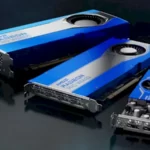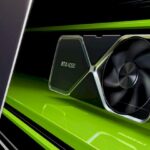The above slide is for only one title, Minecraft, however these are some massive beneficial properties for certain. So we determined to place AMD’s brand-new 22.7.1 driver instantly up in opposition to the 22.3.1 driver from March on its current-generation Radeon RX 6800 XT GPU. We examined video games in DirectX 11 and OpenGL to verify the efficiency beneficial properties, and we additionally in contrast it in opposition to Vulkan outcomes, in addition to testing one DirectX 12 title simply to verify for beneficial properties or regressions there.
All of the exams had been achieved on a check bench with a Ryzen 7 5800X3D CPU, 32GB of low-latency DDR4-3600 reminiscence, and AMD’s personal Radeon RX 6800 XT card. All driver settings had been left at their defaults and we didn’t alter any Windows settings, both. That means the Balanced energy profile, Game Mode was left on, and AMD SmartAccess Memory was enabled.
So, with out additional ado, let’s dive into the benchmarks, we could?
3DMark Fire Strike Benchmark
Okay, this is not a game. In reality, we anticipated no change on this benchmark as a result of AMD has certainly optimized it within the excessive, right? We examined each the unique Fire Strike benchmark, which runs in 1920×1080, in addition to the extra punishing Fire Strike Ultra benchmark that runs in 3840×2160, 4 occasions the decision.
The beneficial properties are small, to make certain—however they’re actual and constant. Like with all the remainder of our benchmarks, we ran every check 3 times, after which took the center of the three outcomes. This prevents our outcomes from being outliers, and ensures that they need to be at the least fairly consultant.
The 3DMark outcomes trace at an attention-grabbing sample. The new driver does enhance GPU efficiency ever so barely on this benchmark, however it additionally raises the normally-very-consistent Physics rating. This rating is principally Fire Strike‘s “CPU” rating, and the brand new driver bettering that appears to imply that the Radeon card is best in a position to make use of our Ryzen 7 5800X3D’s horsepower.
Final Fantasy XIV Endwalker Benchmark
One of our favourite issues about Final Fantasy XIV is that Square-Enix continues to launch new character creator and benchmark instruments with every enlargement. The up to date benchmarks are supposed to raised signify the calls for of the content material within the newest enlargement.
However, the FFXIV benchmarks are literally a succession of smaller scenes performed in sequence, and the benchmark additionally data how a lot time you spend looking at loading screens throughout the course of the exams. This is arguably the extra attention-grabbing end result from this testing. Now, a discount of three.5 seconds might not seem to be that a lot, however do not forget that our check machine is ludicrously quick, and loading this content material off of a PCIe 4.0 SSD. It’s seemingly {that a} slower machine would see a fair greater profit right here.
Phantasy Star Online 2: New Genesis Benchmark
No matter the way you slice it, PSO2:NGS runs rather a lot worse than it ought to on any system. SEGA has some optimization work to do for certain, though we should be aware that the game runs rather a lot higher in its present patch than it did on launch. Unfortunately, the benchmark instrument is predicated on that authentic launch. Hopefully SEGA can comply with in Square-Enix’s footsteps and launch a brand new benchmark with the present model of the engine.
Don’t learn an excessive amount of into the 1920×1080 outcomes. The game has a tough framerate cap at 180 FPS, and scores over 30,000 imply that you simply’re staying right close to that cap for many of the benchmark. This check is not fully deterministic both on account of some randomness within the particle results, and whereas it looks like an enormous distinction, these scores actually aren’t significant.
The extra attention-grabbing achieve is the ~5% uplift in 4K efficiency. Neither of those scores are significantly unhealthy, however the brand new driver appears to have resolved some stuttering within the benchmark, and that seems to be what’s bettering efficiency right here.
Counter-Strike: Global Offensive Benchmark
CS:GO runs fairly nicely on built-in graphics, so why hassle testing it? Well, it is likely one of the hottest video games on Steam, and devoted gamers need absolutely the highest framerates attainable. The check map that we used, referred to as “FPS Benchmark” and created by Mr. uLLeticaL, will not be as demanding as a number of the actual eventualities within the game as of late and so it produces hilariously excessive body charges. The essential half is that they’re constant and consultant, which lets us see the distinction between the drivers.
That is a 4.25% enchancment, which is about what we have been seeing in DirectX 11 video games. It might not be a lot, however an enchancment continues to be an enchancment, so we’re happy to see it.
ARMA III Benchmark
ARMA III is one other game that’s troublesome to check owing to its primarily-multiplayer nature. Fortunately, like with CS:GO, followers have come collectively to create specialised eventualities that play via an automatic benchmark, very similar to these obtainable in different video games. We used the favored “Yet Another ARMA Benchmark” situation with all in-game settings turned to their maximums.
This is our greatest DirectX 11 achieve but, and the most important one general. ARMA III is a singular game in that this can be very reliant on each single-threaded CPU efficiency and primary reminiscence bandwidth. While the engine it makes use of is multi-threaded to a level, it actually needs a super-fast CPU and system reminiscence bus.
Of course, none of that modified between our exams; the one variable that moved is the graphics driver. All the in-game settings are the identical; we checked! This end result actually factors to some CPU utilization optimizations in AMD’s new DirectX 11 driver, simply as we suspected with 3DMark and Final Fantasy XIV. 65.7 FPS on this benchmark is kind of a excessive end result; ARMA gamers, update your drivers instantly.
Wreckfest Benchmark
Wreckfest is a destruction derby-style racing title where gamers can choose from a wide range of destructible autos and both race them or try and smash their opponents out of the working. It’s a surprisingly demanding game contemplating that it initially launched in 2014. Bugbear Interactive’s home-grown ROMU engine appears to be like nice and already ran fairly nicely on Radeon.
Even nonetheless, it runs higher now. We arrange a customized occasion utilizing the Bloomfield Speedway and made certain to match climate situations. There was nonetheless a stunning quantity of non-determinism on this benchmark and so these outcomes had been slightly inconsistent, however our technique of working 3 times and choosing the center gave us a fairly stable enchancment of just below 8% with Adrenalin 22.7.1.
Unigine Superposition Benchmark
Unigine’s Superposition benchmark is a demanding check that makes use of tens of millions upon tens of millions of triangles to show a stunning laboratory scene. It will not be ray-traced, or something; it’s strictly last-gen expertise. Still, it appears to be like completely improbable, and even in 2022 it could put a harm on graphics playing cards.
Superposition serves as a little bit of a bridge for us between our DX11 exams and OpenGL titles. The benchmark helps each APIs, and naturally, the traditional knowledge on Radeon playing cards has been to run it in DirectX 11 mode owing to that mode’s higher efficiency on these playing cards.
Well, as you’ll be able to see for your self, that is not essentially the case anymore. Okay, the DirectX 11 mode nonetheless performs slightly higher. The distinction is vanishingly small, although, and it’s not removed from being run-to-run variance. The OpenGL mode of the benchmark performs excellently on our RX 6800 XT now, and the DirectX 11 mode even sees a really small uplift with the brand new driver. Excellent work, AMD.
Xonotic Benchmark
If you’re looking on the title of that game—pronounced “zone-otic”—and questioning what the heck it’s, don’t fret. Xonotic is a free (as in speech) game primarily based on a closely modified model of the Quake engine. It was forked from an earlier title referred to as Nexuiz when that game determined to go commerical. Xonotic performs rather a lot like older enviornment FPS video games comparable to Quake and Unreal, and it’s a ton of enjoyable with associates.
Testing Xonotic is rather a lot like testing the previous Quake video games was again within the day: you run a timedemo. This signifies that you play again a demo recording on the most pace attainable for the machine after which examine that efficiency in opposition to the unique pace. At the tip of the demo, Xonotic spits out the minimal, common, and most one-second body charges.
We examined Xonotic utilizing the built-in “big key benchmark” demo, and the efficiency beneficial properties are plain to see. It can be simple to argue that 271 common FPS is a lot quick, even for a game like this, however you could possibly actually really feel that 39 FPS low when taking part in, as efficiency would hitch and stutter at occasions. The new driver feels drastically smoother and makes this classic-style FPS a pleasure to play.
RAGE Benchmark
RAGE is certainly one of your writer’s all-time favourite FPS video games. Yes, his style is widely-acknowledged to be horrible. It is a woefully-overlooked game, although, and regardless of releasing approach again in 2011 it nonetheless has completely stellar visuals. It additionally runs like a dream… at the least on GeForce {hardware}.
Before the brand new driver, RAGE was a stuttery, terrible mess on Radeon playing cards. Testing utilizing Adrenalin 22.3.1, the game hitched and stuttered continuous. Despite the framerate counter studying values as excessive as 95 FPS, it felt extra like 45. Let’s see what occurs when AMD throws some optimizations at it.
Well, would you have a look at that. RAGE really has a 60 FPS cap in place usually, and testing in 3840×2160, regardless of the stuttering, was nonetheless giving us common FPS values round 58. That merely would not do, so we cranked the decision all the way in which as much as 7680×4320 and used a mod to uncap the framerate.
That gave us extra helpful values for testing, and the play expertise bears out these outcomes. With the brand new driver, RAGE is easy as silk, and an absolute blast to play at 8K120. It hundreds in noticeably sooner, too.
DOOM (2016) Benchmark
Our final two outcomes are, considerably amusingly, each Doom video games. Doom (2016) was the triumphant return for the sequence after the controversial Doom 3 in 2004. This game got here out again within the days of the Radeon RX 480 and GeForce GTX 980. Lots of of us had been nonetheless utilizing older GPUs than that, like Radeon R9 290X jet engines and even GeForce GTX 580 BBQ grills. It didn’t have Vulkan help at launch, and taking part in Doom 4 on Radeon playing cards was tough till the brand new API was added. Is that also so?
If you might have learn this far, you already know the reply by this level: no. Doom ’16 runs very nicely in OpenGL on the Radeon RX 6800 XT with the 22.7.1 driver. This is such a drastic enchancment over the earlier driver’s efficiency that we’re going to show you a smoothness graph to reveal the distinction.
The green line represents the frametime with the 22.3.1 driver, and the orange line represents the frametime with the 22.7.1 driver. That big spike firstly with the 22.7.1 driver is an artifact of the instrument that we use to seize frametimes, CapFrameX; you’ll be able to ignore that. Overall, the brand new driver is each sooner and drastically smoother than the previous driver.
ZDoom Eviternity Benchmark
On the face of it, it might appear foolish to benchmark a mod for a 29-year-old game. Believe it or not, mods for that game can nonetheless put a heavy harm on trendy techniques. We’re testing ZDoom, a source port of Doom (1993), together with the extent set Eviternity. The twenty sixth map on this stage set, the primary map of its sixth episode, is named Transcendence, and it’s considerably infamous for its horrible efficiency. Most of this comes all the way down to gross inefficiencies within the Doom engine itself, which was by no means meant to deal with ranges of this dimension or complexity.
As with Doom ’16, we examined ZDoom in each OpenGL and Vulkan. Surprisingly, regardless of AMD saying nothing about Vulkan beneficial properties on this driver update, the brand new driver runs significantly higher in each OpenGL and Vulkan on this specific benchmark. We’re able to chalk that as much as peculiarities of ZDoom, as its Vulkan renderer might be carefully associated to its OpenGL renderer.
Cyberpunk 2077 Benchmark
Bringing up the rear is our sole DirectX 12 check. AMD has not talked about something shortly about its DX12 driver, however with all this work happening alongside, we wished to ensure there had not been any regressions in Radeons’ DirectX 12 or DXR ray-tracing efficiency. Cyberpunk 2077 makes the proper check.
Using the built-in benchmark, we really see a small efficiency enchancment in Cyberpunk 2077 between the previous and new drivers. This benchmark will not be deterministic, however it’s fairly dependable from run-to-run and this end result was pretty constant. Clearly AMD’s been attempting to shore up its barely sub-par ray-tracing efficiency. With these settings, Cyberpunk 2077 is kind of playable and nonetheless appears to be like fairly good.
OpenGL Emulator Testing
One of the primary makes use of of the OpenGL API for avid gamers on Windows is to play video video games in console {hardware} emulators. Most emulator purposes are open-source software program, and that signifies that the builders typically desire to make use of cross-platform APIs. As a end result, you do see a desire for OpenGL amongst emulator authors.
Recently, that desire appears to have shifted towards Vulkan. The newer and lower-level API has all the cross-platform benefits of OpenGL, but not one of the legacy cruft of that aged API. Vulkan works nicely on GPUs from each vendor, albeit with some inconsistencies in characteristic and extension help.
Still, there are a number of emulators on the market that carry out or perform greatest with OpenGL. One of essentially the most notable is CEMU, the Wii U emulator. CEMU famously acquired Vulkan help on the very finish of 2019, however sure mods and “graphics packs” for the emulator nonetheless require OpenGL. That basically meant that Radeon gamers didn’t have entry to these as a result of OpenGL efficiency on these playing cards was so poor.
Testing at this time, we scaled The Legend of Zelda: Breath of the Wild all the way in which to 8K decision (that is 7680×4320) with an uncapped framerate, and it ran at a fairly-consistent framerate within the high-30s outdoor. That’s beautiful efficiency in comparison with earlier this 12 months, when this identical card struggled to run Super Smash Bros at a playable framerate no matter settings. You do not even want to use the AMD-specific graphic packs to repair up damaged options on this game, and you’ll clearly enhance efficiency by reducing the decision.
We additionally examined different emulators, together with PCSX2 for the PlayStation 2, Yuzu emulator for the Nintendo Switch, and Mupen64Plus on Retroarch. All of them labored flawlessly with the brand new driver. This is nice information for emulation followers utilizing Radeon playing cards in addition to built-in Radeon graphics.
Final Conclusions
Regular readers will acknowledge that our check set this time round was fairly unusual. We didn’t run our common batch of video games as a result of we usually deal with testing newer and extra up-to-date titles, and people video games don’t usually use DirectX 11 or OpenGL as their API.









